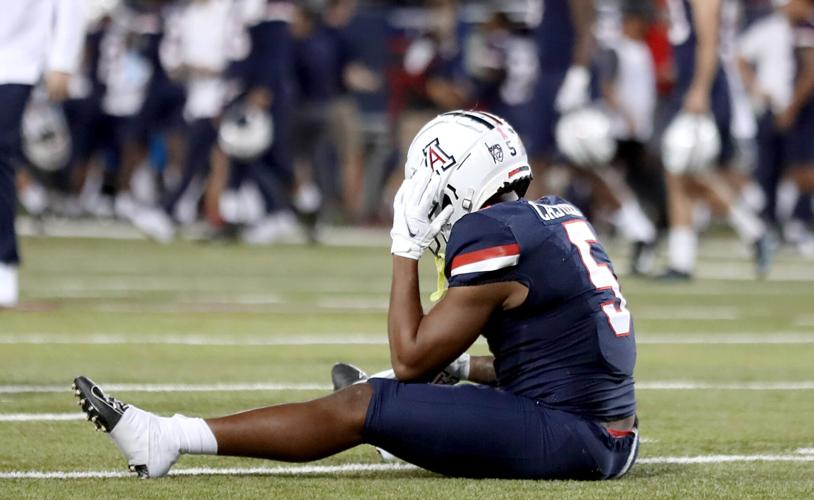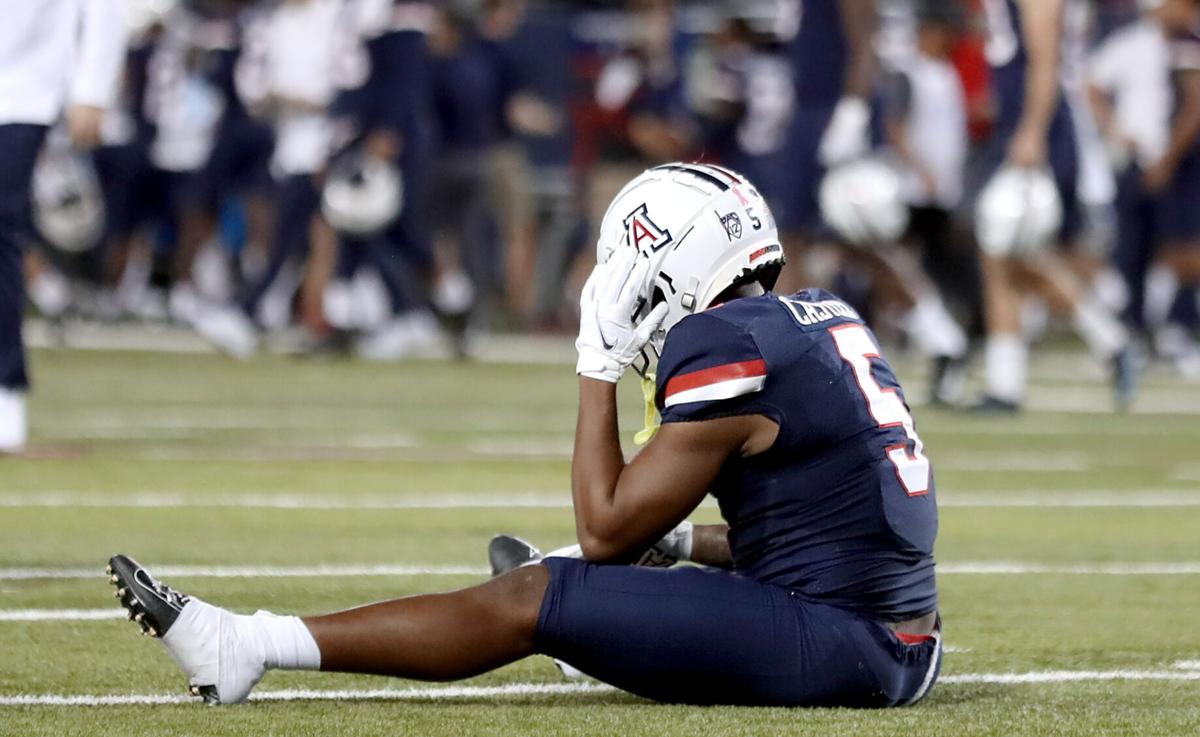“We have to play 60 minutes of football.”
“We just gotta finish.”
You’ve heard that sentiment countless times from coaches and players on struggling football teams. You’ve heard it a lot lately emanating from the Lowell-Stevens Football Facility.
The 2021 Arizona Wildcats are a classic case of a team that can’t — or at least hasn’t to this point — put a complete game together.
“We’re playing like 47 minutes,” said UA coach Jedd Fisch, whose team visits USC on Saturday. “And we’re just picking which 47 we want to play.”
In almost every game they’ve played this season, the Wildcats have hit a rough patch that has turned competitive contests into unwinnable ones. Sometimes it happens in the first quarter. More often than not lately, it’s been happening in the fourth.
In this week’s “Cats Stats,” we’ll issue something of a quarterly report — a quarter-by-quarter breakdown of Arizona’s breakdowns. When are they happening? Why are they happening? Let’s take a look:
We’ll start with the basics — Arizona’s point differential in each quarter. You’ll notice a pattern here.
First quarter: minus-18 (30-48)
Second quarter: minus-23 (29-52)
Third quarter: minus-30 (25-55)
Fourth quarter: minus-42 (16-58)
The differential increases each quarter. That could be a sign that the Wildcats’ opponents — none of which entered this season with a 12-game losing streak — have superior depth. It could mean that game plans are working OK early on but not enough adjustments are being made. Or it could simply be the result of a series of unique calamities that have struck at inopportune times.
It’s probably all of the above, and it’s not the same issue every week. Looking at the quarter-by-quarter breakdown in a different way helps illustrate that point:
Remove the San Diego State game — in which Arizona trailed 21-7 after the first quarter — and the first-period point differential shrinks to minus-4.
What happened in that quarter? The offense couldn’t move the ball. The defense missed tackles, leading to big plays. The special teams allowed a punt to be blocked and returned for a touchdown. It was a bad 15 minutes of football in every facet.
Take out the first two games — BYU and SDSU — and Arizona would have a point differential of plus-2 in the second quarter.
The Cougars outscored the Wildcats 14-3 in that period after a scoreless first. This was the first time Arizona’s season-long red-zone issues cropped up. The Wildcats drove inside the 20-yard line twice but came away with only three points.
The second quarter against the Aztecs was basically a continuation of the first. The offense went three-and-out on every single possession. The defense cracked. SDSU won the period 14-0.
Remove the Colorado game — and boy, wouldn’t Arizona like a do-over on that one — and the third-quarter differential goes from minus-30 to minus-9.
The Wildcats trailed the Buffaloes 6-0 midway through the period. The offense again was scuffling, but it was a one-score game. Then the following happened in just over five minutes of game time:
Arizona allowed another blocked punt that was returned for a touchdown.
Quarterback Gunner Cruz — who had suffered a severe injury to his throwing hand three plays earlier — tossed a pick-six.
After a UA punt, the Wildcats’ defense — which had kept the Buffs out of the end zone the entire game — yielded a 62-yard touchdown pass.
Colorado won the quarter 21-0. The Buffs won the game 34-0.

Editor’s note: Each week throughout the football season, we’ll take an in-depth look at the Arizona Wildcats from a statistical perspective.
If you include only the first three games — BYU, SDSU and NAU — Arizona would have a fourth-quarter point differential of plus-6.
The Wildcats kept battling in each of those games. They rallied from a 21-3 third-quarter deficit against the Cougars to make it a one-score game. They outscored the Aztecs 7-3 in the second half. They came within a two-point conversion of tying the Lumberjacks.
As Fisch said after last week’s loss to Washington: “I love the way that our guys fight. But on top of fighting, you need execution.”
Arizona’s effort level hasn’t waned since the first three games. But the Wildcats have cratered in the fourth quarter. They’ve been outscored 48-0 in the final period since Pac-12 began. Ouch.
Some of those collapses featured common themes. Let’s take a quick look at each one:
Opponent: Oregon
4Q score: 17-0
What went down: The Wildcats trailed 24-19 against the then-No. 3 Ducks entering the fourth. A field goal made it 27-19. A three-and-out — Arizona’s only one of the night — preceded an Oregon TD that made it 34-19. Then Jordan McCloud, who had helped put the offense in scoring position multiple times but was plagued by interceptions, threw a pick-six.
Opponent: UCLA
4Q score: 10-0
What went down: In this case, it was McCloud himself. With Arizona trailing 24-16 and facing first-and-10 at its 43, McCloud got sacked and lost the ball. In the process, the Wildcats’ most effective quarterback suffered season-ending knee and ankle injuries. Cruz replaced him, and the offense stalled. A long TD run made it 31-16. A UCLA field goal made it 34-16.
Opponent: Colorado
4Q score: 7-0
What went down: Not much. The game was decided in the third. The Buffs led 27-0 entering the fourth. Will Plummer had replaced Cruz at that point. The Wildcats had two fourth-quarter possessions. One ended in an interception, the other on downs. The UA defense surrendered a garbage-time touchdown in between.
Opponent: Washington
4Q score: 14-0
What went down: Arizona led 16-7 entering the period. The Wildcats had first-and-10 at the UW 28. Plummer threw an interception on a screen pass. The Huskies drove 71 yards for a touchdown in just over a minute. Arizona then went three-and-out. Washington scored another TD to take the lead. The Wildcats never seriously threatened in the final 6:44.
Arizona was never the same after Plummer’s pick. It happened with 12:58 to play. Forty-seven minutes of good football isn’t enough.






